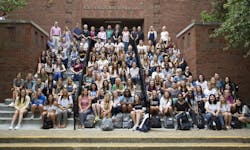Create Community in Interior Design Education
Building community in the academy represents some of the most challenging work I have undertaken in the field over a 30-year period. Many factors contribute to challenges educators experience in departments, notwithstanding external factors in institutions, that counter teamwork and collaboration.
We all know these issues well. We have been taught to primarily be researchers and practitioners working in solitude, with a paucity of time to truly and fundamentally engage with one another. Moreover, we often lack true incentives for collaboration, other than a vague sense that we should do it.
Poor meeting/event parameters and modes of execution further dilute community time together. And, perhaps most significantly, administrative leaders above us can misunderstand or misrepresent collegiality for lack of rigor or critical analysis in our work.
Ways to Engage Students
Community efforts in the University of Kentucky School of Interiors began under my leadership with simple events while building on activities one might find in place for a program of any size: project reviews, product representative visits, faculty meetings and student organization gatherings.
From these early efforts, the faculty and I learned that students eagerly wanted to engage both formal and informal mentors. Upper-level students enjoyed opportunities to share the successes and pitfalls of their own design journeys, while younger students began to feel more at ease with the life of design we fostered as a School.
We also quickly recognized that students themselves could capably lead these efforts so that, by the next year, students in each studio brainstormed and offered programming run by students for students, including the popular “studio recess” during which students played games to de-stress.
To these, the faculty mapped additional programming including a first day photograph which included the whole School, and a first- and last-day-of-term School meeting (complete with awards, a farewell song and senior superlatives) We also introduced the formalization of a group advising system where I, as director, and personnel from our College advising office, visited each studio in advance of registration to prepare students for meaningful advising meetings.
Collectively, we intended all these efforts to remind students of the community within the School that provided a platform for announcements and celebration.
[Related: Next-Generation Designers Offer Insight into Future of Design]
During this period, the faculty and I also established and committed to travel each semester and throughout every year of the program. Now a tenet of our instructional approach, we underscored the importance of travel to enhance curricular instruction by experiencing relevant design firsthand. We embedded travel costs into tuition through a student fee, enabling all students to have some support to learn in this way. Some of the best community-making came from these travel experiences and visits to the field in cities and sites large and small in the Ohio Valley and beyond.
Community events focused on faculty, too, through the implementation of sharing sessions where we delved into wide-ranging topics relevant to higher education, design and our classrooms. We shared and received great examples of collective work and practice in the process by inviting people from the campus and beyond to help us with important curricular and co-curricular understanding that, in turn, benefitted students and faculty alike.
Share With and Expand Your Community
As these various forms of community-making unfolded, we shared our camaraderie with others inside and outside our community. Through both student-led social media efforts and electronic communication from me as director, the spirit of the School reached alumni, university officials, community partners and other stakeholders underscoring a reputation for a culture of community-engaged work.
As director, I often stated “teamwork makes the dream work,” and I know the value of that team attitude on matters across many scales. The presence of the steady hands and minds of faculty with a rich diversity of life, academic and practice experience represents perhaps the single most important factor to fostering positive community both within and by design.
As a legacy program with leaders from the past who both understood and put into action community work and civility, it was easy to maintain that rich tradition of the School for the years that I found myself fortunate to lead.
As an interior design educator, I encourage you to build community opportunities for faculty, students, alumni, and other industry leaders and partners at multiple scales. I truly believe that, as part of a quality education, the community activities we lead and participate will inspire and shape young design talent to greater dividends far beyond their short time in the academy.
Read next: Bold Design Education Environment at Lassonde Studios
Patrick Lee Lucas is associate professor at the University of Kentucky School of Interiors.
